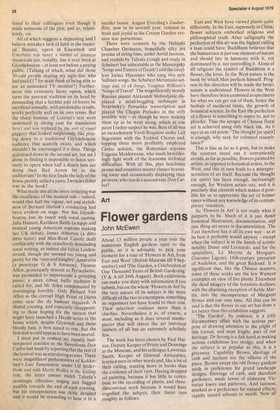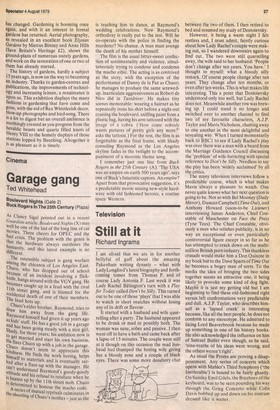Flower gardens
John McEwen
About 13 million people a year visit the numerous English gardens open to the public, so it is advisable to pick your moment for a tour of 'Flowers in Art, from East and West' (British Museum till 9 September) and 'The Garden, a Celebration of One Thousand Years of British Gardening' (V & A till 26th August). Both exhibitions can make you dizzy with information if you submit, but on the whole 'Flowers in Art' by the very nature of its subject is the more difficult of the two to encompass, something its organisers too have found to their cost. Their selection confuses more than it clarifies. Nevertheless it is, of course, a must, including as it does several masterpieces that will shiver the art historical timbers of all but an extremely scholarly few.
The work has been chosen by Paul Hulton, Deputy Keeper of Prints and Drawings at the Museum, and his colleague Lawrence Smith, Keeper of Oriental Antiquities, learned men in other words and, like a lot of their calling, trusting more in books than the evidence of their eyes. Having dropped oil painting, because it has little to contribute to the recording of plants, and threedimensional work because it would have engulfed the subject, their thesis runs roughly as follows. East and West have viewed plants quite differently. In the East, supremely in China, flower subjects embodied religious and philosophical truth. After calligraphy the perfection of this art was the highest calling a man could have. Buddhism believes that the human race is just one element of nature and should live •in harmony with it, not dominated by it, nor controlling it. Alone of all religions the symbol of Buddhism is a flower, the lotus. In the West nature is the book by which Man perfects himself. Progress in this direction will be made the better nature is understood. Flowers in the West have therefore been examined as specimens for what we can get out of them, hence the herbals of medieval times, the growth of botanical science. In the East the perfection of a flower is something to aspire to, not to plunder. Thus the apogee of Chinese floral art is achieved using only black ink. As it says in an old poem: 'The thought [or spirit] is enough, why seek for coloured resemblance?'
This is fine as far as it goes, but to make the contrast stand out it conveniently avoids, as far as possible, flowers painted by artists, as opposed to botanical artists, in the West, and this in turn leads to a misrepresentation of art itself. Because the thought (or spirit) has been enough, increasingly enough, for Western artists too, and it is precisely that element which makes it possible for us to appreciate the art of former times without any knowledge of its contemporary intention.
So 'Flowers in Art' is not really what it purports to be. Much of it is just dumb botanical illustration, documentation, and one thing art never is documentation. The East therefore has it all its own way — as at its best it probably would anyway — except when the subject is in the hands of artists: notably Durer and Leonardo, and for the specialists, Le Moyne de Morgues, Giacomo Ligozzi, 16th-century precursor of Audubon, and the great Redoute. It is significant that, like the Chinese masters, some of these works are the few Western examples on view of live plants. Elsewhere the dead imagery of the botanists declines, with the charming exception of Keble Martin, into the incompetence of Margaret Stones and our own time. All that can be said is that the flower in our art has done a lot better than this exhibition suggests.
'The Garden', by contrast, is a jolly documentary affair with the serious purpose of drawing attention to the plight of this formal, and most fragile, part of our heritage. Dr Strong is a dab hand at making serious exhibitions less stodgy, and when the subject is as popular as this, it is a giveaway. Capability Brown, shortage of cash and laziness are the villains of the piece. Brown swept the old flower gardens aside in preference for grand landscape designs. Shortage of cash, and therefore gardeners, made lawns of elaborate Victorian knots and parterres. And laziness, masked as a preference for natural effects, rapidly turned arbours to weeds. Now all has changed. Gardening is booming once again, and with it an interest in formal gardens has returned. Aerial photography, as revealed in an excellent book Elysian Gardens by Marcus Binney and Anne Hills (Save Britain's Heritage L2), shows the ground-plans of numerous stately gardens, and work on the restoration of one or two of them has already started.
The history of gardens, hardly a subject 15 years ago, is now on the way to becoming an industry. Thanks to garden-centres and Publications, the improvements of technology and increasing leisure, a renaissance is Upon us. This exhibition displays the many fashions in gardening that have come and gone, with the aid of Rex Whistlerish decor, blow-up photographs and bird-song. There is a lot to digest but an overall ambience is soothingly created as you progress from the heraldic beasts and quartz filled knots of Henry VIII to the homely displays of those stations lopped by Beeching. Altogether it is as pleasant as it is timely.
111■Moimmew



































 Previous page
Previous page